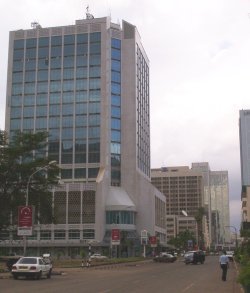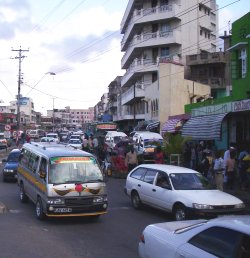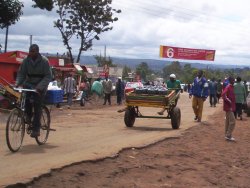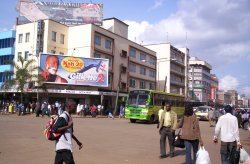|
TOURISM
IN KENYA
Great Rift Valley
Beautiful
countryside
Hotels
& Lodges
Kenya's
Coast
Economy >
Government
Kenya
National
Parks
Lake
Victoria
The
People of Kenya
Wildlife

Barclays Plaza in the centre of Nairobi.

Jomo Kenyatta Avenue in the coastal city of
Mombasa.

An agricultural town in the Rift Valley.

A street in the Kenyan capital, Nairobi.
|
The Economy
Kenya’s geographical
features have been its greatest economic assets right from the birth of
the state as a British protectorate.
The British were more interested in the Kenya – Uganda Railway, built
from 1895 to 1901 and Kenya just happened to be a piece of real estate
lying between the Buganda Kingdom and the East African coast.
Economic utilization of Kenya’s physical features began with the
hunting of game for ivory leopard skins, rhino horns and other
trophies. Trade in the items flourished between the hinterland and the
coast, from where ships docked, ready to sail to Europe, Middle East
and the Far East.
Tourism emerged in this era, with upper class visitors from Europe and
America. A former US President, Theodore Roosevelt, hunted in Kenya in
the early 1900’s. Trophy hunting eventually declined while tourist
numbers grew over the 20th century. Currently, tourism is among the top
5 industries in Kenya, raking in billions of shillings annually.
Kenya’s highlands served to attract European settlers in large numbers,
out to savor the pleasant year-round climate and to exploit fertile
volcanic soils. Majority of settlers were from Britain and by 1920,
their numbers were sufficient enough for the then British East Africa
protectorate to be officially declared the Kenya Colony.
The agricultural economy catalyzed the development of trade, banking
and transport sectors. Industrial production came into place, attracted
by skilled European manpower, agricultural produce and the railway. The
local people were inculcated the tenets of capitalism as they joined
the growing economy first as laborers, then as civil servants and petty
traders.
After independence in 1963, agricultural production through land
ownership, passed into the hands of the African people. Currently,
agriculture is a major economic activity, employing over 60% of the
national population, both directly and indirectly.
Kenya ‘s varied topography
is traversed by a network of roads connecting all corners of the
nation. Admittedly, some of the roads could use better maintenance but
they are largely passable. The main railway line to Uganda remains an
avenue for cargo and passenger transportation.
Electric energy is lighting up homes and powering industry in all towns
and population centers. An impressive telecommunications infrastructure
is in place, assuring Kenyans of worldwide interconnectivity and
enabling visitors to stay in touch with family and business back home.
Internet related activities are recording phenomenal success as
increasing numbers of Kenyans gain proficiency in information systems
management and development.
The Government of Kenya has taken a pragmatic approach to globalization
and its relationship to our economy. There is recognition of the need
to take into account the welfare of the people and the long-term
interests of the Republic. In 2006, the economy grew at a rate of 6%
for the first time in over thirty years, indicating that political and
economic reforms of the previous 15 years were paying off.
As the orange rays of the setting sun bounce off the towering office
buildings of Nairobi, its difficult not to marvel at the astounding
progress witnessed on this landscape in the past century.
Top
|








